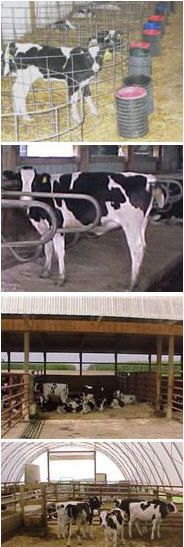



The “Best” Dairy Calf Housing Design?
By Neil Broadwater, Regional Extension Educator-Dairy, University of Minnesota Extension. There are many different housing ideas, concepts, and designs being used to raise dairy calves. What is the best housing design for raising dairy calves?The answer is there is no “best” design. Calves can be raised in many different kinds of facilities, whether it is new or a remodeled building on the farm. However, every design involves trade-offs.
Choosing the right calf facility for your operation depends on the capital, labor, and management resources available. Making the best use of those resources to provide a healthy environment for the calf is what it takes to be successful.
At calfnotes.com, Dr. Jim Quigley wrote an article entitled, Basics of Calf Housing, pointing out the “four fundamental requirements for a successful calf raising housing system.” I would like to expand on those four points for this article:


-
Ventilation– Proper ventilation means providing fresh air to remove organisms from the environment -- less dust, eliminating noxious odors, removing excess moisture and excess heat. However, too much air movement can chill the calf. Calf hutch design should allow steady air movement without draft. For calves housed inside, ventilation needs increase with age and as temperatures rise. Calves up to two months of age need a ventilation rate of 100 cubic feet per minute (cfm) of air in hot weather, 50 cfm in mild weather and 15 cfm in cold weather. Calves from two to 12 months of age need a ventilation rate of 130 cfm during hot weather, 60 cfm during mild weather and 20 cfm during cold weather.
-
Isolation – The calf facility needs to have pens that prevent direct contact among calves from birth to at least two weeks after weaning. This reduces the risk of young calves transmitting diseases to each other. Hutches should be located at least 2 feet apart to prohibit facial contact of calves. Large-group pen housing increases the odds of more respiratory disease, and increases the odds of diarrhea and its severity. Group post-weaned calves by age and size with 3 to 5 animals per group. At about 4 months of age, groups of 6 to 12 are acceptable.
-
Comfort – Place hutches on well-drained material to encourage drainage of urine and rainfall away from calf. Provide feed and water outside the hutch to keep manure and urine away from resting area. Calves housed in individual pens should have 32 square feet per animal. Calves housed in groups should have 28 square feet per animal. The optimal outdoor temperature for calves is around 70° F. Calves can maintain a relatively constant body temperature when the environmental temperatures range between 45 to 80° F. Calf raisers need to think about what changes in management practices need to be made when the temperatures are outside of this range. For most newborn calves, the lower critical temperature is around 50° F. Below this temperature, calves have a higher maintenance energy requirement. When temperatures are above 80°, calves can quickly become dehydrated if free choice water is not available. Avoid housing systems that place calves on cold concrete, rubber mats or slatted floors. High humidity increases heat stress on the animal. If ventilation is poor, even outdoor temperatures between 30 to 70° F may be enough to create relative humidity. Relative humidity in calf facilities needs to stay between 50 to 70 percent.
-
Economy – Dr. David Kammel, U of WI Extension Agricultural Engineer, in a 2005 publication entitled, “Heifer Housing for Custom Raisers” estimates that calf housing costs from birth to weaning range from $0.08/calf/day for a group pen housing system up to $0.35/calf/day for a post-frame calf facility. The cost of a home built calf hutch ($0.11/calf/day) was less expensive than the cost of purchasing a hutch ($0.18/calf/day) with a greenhouse structure costing around $0.16/calf/day. He also looked at housing costs for calves from weaning to 6 months of age. Costs per day ranged from $0.03/calf/day for a fenced pasture to $0.24/calf/day for a youngstock transition barn. Materials for a self-built super calf hutch cost $0.08/calf/day and a purchased super calf hutch was around $0.17/calf/day. I include these costs for comparison purposes only as your costs will differ. In making a decision about a housing facility, one must consider if labor and other associated costs can be reduced with a more expensive system.
August 2007



